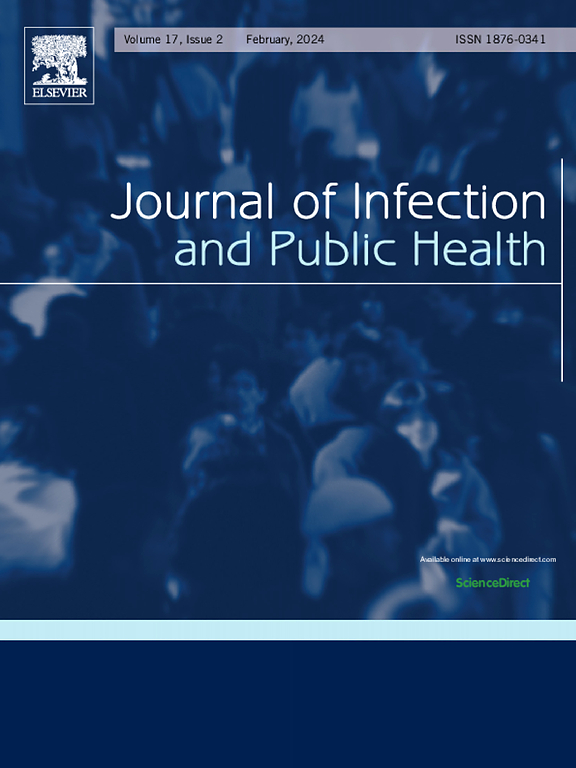海湾合作委员会国家结核病负担的流行病学趋势和预测:1990-2021年全球疾病负担的证据
IF 4.7
3区 医学
Q1 INFECTIOUS DISEASES
引用次数: 0
摘要
结核病(TB)仍然是一个重大的全球卫生问题。尽管海湾合作委员会(GCC)国家的结核病发病率相对较低,但它们面临着独特的挑战,特别是来自结核病流行地区的大量移民劳动力。了解这些国家结核病负担的趋势对于指导公共卫生战略至关重要。方法:我们使用全球疾病负担(GBD)研究的数据分析了GCC国家1990年至2021年的结核病趋势。联合点回归评估了时间趋势,ARIMA模型用于预测未来的结核病发病率、死亡率和DALYs。这些指标考虑了年龄标准化死亡率(ASMR)、DALYs率(ASDR)和发病率(ASIR)。数据可视化,包括地形图和趋势图,也使用R和MS Excel创建。从1990年到2021年,海湾合作委员会国家的结核病发病率、死亡率和伤残调整生命年呈稳步下降趋势。年龄标准化死亡率(ASMR)的平均年百分比变化(AAPC)下降了- 5.39 %,而年龄标准化DALYs率(ASDR)的下降率略高,为- 5.50 %。到2031年的预测预测将继续下降:年龄标准化发病率(ASIR)将从2022年的28.4 / 10万下降到2031年的5.4 / 10万,同期死亡率预计将从3.87 / 10万下降到2.39。DALYs预计将从2022年的103.5年下降至2031年的62年。卡塔尔和沙特阿拉伯等国取得了显著进步,卡塔尔的死亡率降低了95.56% %。然而,阿联酋的发病率和DALYs降低了61.18% %,死亡率却增加了26.71% %。结论海湾合作委员会国家的结核病控制呈现积极趋势,反映了公共卫生干预措施的成功。然而,挑战依然存在,特别是移民人口中结核病的高流行率。持续努力和有针对性的干预措施对于保持消除结核病方面的进展至关重要。本文章由计算机程序翻译,如有差异,请以英文原文为准。
Epidemiological trends and forecasting of tuberculosis burden in the Gulf Cooperation Council countries: Evidence from global burden of disease 1990–2021
Background
Tuberculosis (TB) remains a significant global health concern. Although the Gulf Cooperation Council (GCC) countries have relatively lower TB incidence rates, they face unique challenges, particularly with a large migrant workforce from TB-endemic regions. Understanding trends in TB burden in these countries is essential for guiding public health strategies.
Methods
We analyzed TB trends in GCC countries from 1990 to 2021 using data from the Global Burden of Disease (GBD) study. Joinpoint regression assessed temporal trends, and ARIMA modeling was used to forecast future TB incidence, mortality, and DALYs. The metrics considered age-standardized mortality rates (ASMR), DALYs rate (ASDR), and incidence rates (ASIR). Data visualizations, including choropleth maps and trend graphs, were also created using R and MS Excel.
Results
From 1990–2021, TB incidence, mortality, and DALYs showed a steady decline across the GCC countries. The age-standardized mortality rate (ASMR) decreased by an average annual percentage change (AAPC) of −5.39 %, while the age-standardized DALYs rate (ASDR) decreased at a slightly higher rate of −5.50 %. Forecasting through 2031 predicts a continued decline: the age-standardized incidence rate (ASIR) will fall from 28.4 per 100,000 in 2022–5.4 by 2031, and mortality is expected to decline from 3.87 per 100,000 to 2.39 over the same period. DALYs are projected to decrease from 103.5 in 2022–62 by 2031. Countries like Qatar and Saudi Arabia showed significant improvements, with Qatar achieving a 95.56 % reduction in mortality. However, the UAE with a 61.18 % reduction in incidence and DALYs, showed a 26.71 % increase in mortality.
Conclusions
TB control in GCC countries shows positive trends, reflecting successful public health interventions. However, challenges remain, particularly the high prevalence of TB among migrant populations. Continued efforts and tailored interventions are essential to sustain progress toward TB elimination.
求助全文
通过发布文献求助,成功后即可免费获取论文全文。
去求助
来源期刊

Journal of Infection and Public Health
PUBLIC, ENVIRONMENTAL & OCCUPATIONAL HEALTH -INFECTIOUS DISEASES
CiteScore
13.10
自引率
1.50%
发文量
203
审稿时长
96 days
期刊介绍:
The Journal of Infection and Public Health, first official journal of the Saudi Arabian Ministry of National Guard Health Affairs, King Saud Bin Abdulaziz University for Health Sciences and the Saudi Association for Public Health, aims to be the foremost scientific, peer-reviewed journal encompassing infection prevention and control, microbiology, infectious diseases, public health and the application of healthcare epidemiology to the evaluation of health outcomes. The point of view of the journal is that infection and public health are closely intertwined and that advances in one area will have positive consequences on the other.
The journal will be useful to all health professionals who are partners in the management of patients with communicable diseases, keeping them up to date. The journal is proud to have an international and diverse editorial board that will assist and facilitate the publication of articles that reflect a global view on infection control and public health, as well as emphasizing our focus on supporting the needs of public health practitioners.
It is our aim to improve healthcare by reducing risk of infection and related adverse outcomes by critical review, selection, and dissemination of new and relevant information in the field of infection control, public health and infectious diseases in all healthcare settings and the community.
 求助内容:
求助内容: 应助结果提醒方式:
应助结果提醒方式:


